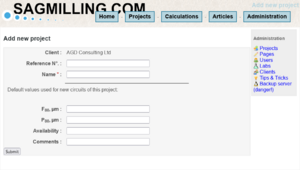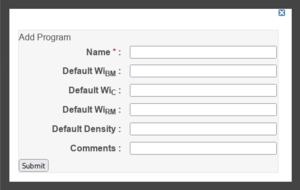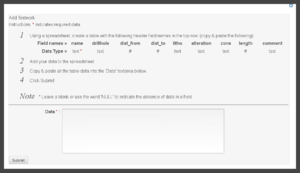Entering test results
Contents
Access Level
Anyone with 'user' access level (privileges) and who has been set by an administrator to have 'read/write' access to a project will be able to enter test results for that project.
Users with 'read' access will be able to view test results, but not edit them or add new results. Contact your administrator if you need access to edit or add test results.
Entering Test Results
A newly created project will require entry of test results before circuit models may be created and run. To enter test results, click the "Testwork" link.
The testwork page consists of a series of links to the test pages for storing different types of test results. It will first show a summary of all the test programs and available types of test results that have been entered — but since no test results are entered, the list will be blank.
General Concepts
The testing program should collect a series of samples corresponding to a particular interval of drill core, mine bench or some other reasonably uniform composite. Each sample will then have a series of tests conducted on it depending on which model (or models) are intended to be run. In order to properly index and organize the databases, each sample must have the following:
- Program: Used to group tests that were all part of the same batch of testing. Often this is denoted by the date of testing, lab name or part of the orebody that was being examined. Example Program names are '2013', 'west extension' or 'infill'.
- Sample: Sample name that is unique within a project. This can be a number, a drillhole number:from-to interval, or any other unique identifier. The same sample name will be used in all the tests in order to tell the database that "this is the same sample" when it goes looking to gather information.
The Sample names must be declared before test results may be entered for them.
If the database finds two different test results (for the same test) with the same Sample name, then the two test results are merged by arithmetic averaging. For example, if two ball mill work index tests at different closing screen sizes were performed on the same sample, and entered with the identical sample name, then the database will average the work index (for modelling) and will also average the test F80, gpr and P80 for display.
Entering a batch of test results
- download the test template spreadsheet
or
- using a spreadsheet provided by you laboratory, insert a row above the table of results and insert the field names for a particular test.
then
- define the sample names to be entered,
- cut & paste a table of values from the spreadsheet in a "batch";
Test Types
Click on the link of the type of test that you want to enter date for. The abbreviations (on the list of links) for the different tests are:
Laboratory tests of grindability, impact, abrasion and compression.
- wibm: Bond ball mill work index (sometimes called "BWI")
- wirm: Bond rod mill work index (sometimes called "RWI")
- wic: Bond crushing work index (low energy impact, sometimes called "LEIT", "IWI" or "CWI")
- dwt: Drop Weight tests, SMC Test ® of SMCC Pty Ltd. and JK DWT (values stored include A×b and DWI)
- sgi: SAG Grindbility Index (also SAG Power Index™ or SPI™ of SGS Mineral Services; originally called a "Starkey SAG test"Starkey et al, 1994)
- ai: Bond abrasion index
- ucs: Unconfined Compressive Strength, a detailed geotechnical test conducted on drill core
- pli: Point Load Index, a field-test conducted on drill core
Geological tables, used for organizing and partitioning samples, or as proxies for test results.
- litho: Lithological, alteration and sample acquisition data, including drill hole intervals
Automatically generated tables. Assembled by the program out of the tests entered into the laboratory test tables.
- Testwork summary: Summarizes all the test results entered for a project, including samples with inadequate information for modelling.
Extra table, accessible to your administrators
- Laboratory Listing: Listing of laboratories and their colour schemes for plotting results.
Summary table, "All" results
The summary table of "All" results shows the listing of significant test results against the sample names. This provides a quick reference to check which samples contain sufficient test results to operate a model.
This summary table is automatically generated and can not be manually edited. In order to adjust a value in this table, it is necessary to modify the individual testwork pages.


